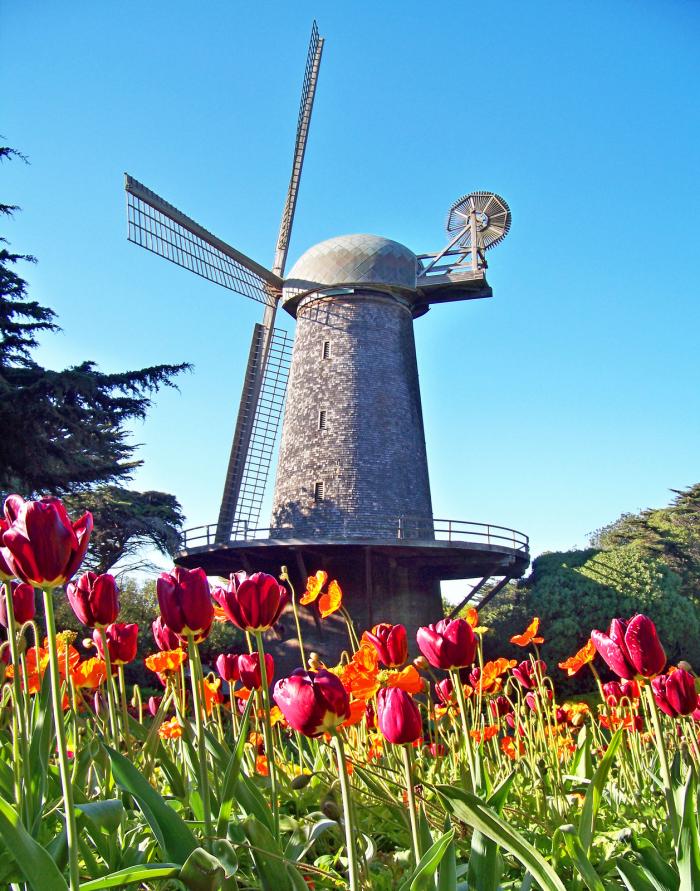10 Most Visited Places in Golden Gate Park

Amidst the busy city of San Francisco lies more than a thousand acres of sand dunes turned to a massive green park of over 75,000 trees. Similar in shape of New York's central park but only larger, Golden Gate Park stretched from Ocean Beach to Stanyan St. Originally build as an ultimate haven away from the city's noise and commotion, ironically, it is now the 3rd most visited park in the U.S. with approximate of 13 million visitors every year. For over the years since 1870, the park was preserved as a place to relax, play and nurture culturally with following attractions to commune with:
Windmills & Tulips
Driving thru the Great Highway, stop by and start your leisure walk in Golden Gate Park from the Ocean Beach. Two windmills were constructed here to pump water to irrigate the plants in the park. The North Windmill, later called the Dutch Windmill was first completed in 1902 on the north side of the park facing the Pacific Ocean. The South or Murphy's Windmill was built in 1905 on the south side of the park and was the largest windmill in the world. Both windmills were operating for several decades and soon disregarded. The exterior of the North Windmill was repaired in 1980 and created the Queen Wilhelmina Tulip Garden on its side. The cap of the South Windmill was shipped to Netherlands in the early part of 2000 for restoration.
Most people took different photographs of the historical South Windmill of being the largest in the record. The scene of the windmill of the north and bed of tulips are so impressive that you will witness several weddings here especially during the season of its bloom on February and March.
Beach & Park Chalet
Open from 9am to 10pm on Sundays to Thursdays; 9am to 11pm on Fridays and Saturdays
Located next to the Dutch Windmill and Queen Wilhelmina Tulip Garden is a historical 2-story building opened in 1925, the Beach Chalet. A Spanish-style designed by Willis Polk served as a changing room for people soaking in the ocean. After a decade, the building was turned into a brewpub and restaurant. Glance from the past in the first floor of the building where murals of distinguished events in San Francisco dated back to 1894, a miniature three-dimensional model of Golden Gate Park model, and memorabilia gift shop all located in the first floor, the Park Chalet which served as a visitor center. In the second floor led by intricately carved staircase are restaurant and homemade brewery pub open for breakfast, lunch and dinner with live entertaining atmosphere.
American Bison Paddock
Also here in the western end of the park, a large fenced-in portion where you can find the Buffalo Paddock. They were one of the earliest animal settlers in the park in 1890 transported from the Great Plains and become a treasured tradition in memory of the Wild West. They were salvaged from extinction due to slaughter for their meat, hides and fur. The herds you can view in the park today are descendants of bison given to the mayor, Dianne Feinstein by her husband on her birthday in 1984. Visitors enjoyed the bison's enormity, its behavior and their grasses or weeds grazing not much of a show or any exciting actions but rather calming and mostly in standing or sitting position.
Model Yachts in Spreckels Lake
Located in the northern side of the park near 36th Avenue and next to the Buffalo Paddock is the Spreckels Lake, the home of San Francisco Model Yacht Club. Different yacht both radio controlled and wind sail model are perfect for this water due to its vertical edging specifically design for this toy for small and big boys.
Strawberry Hill
Strawberry Hill is a piece of land located in the middle of Stow Lake named after the wild strawberries that once covered the hill with manmade waterfall connected by two bridges to the mainland. It is a great place for flexing your muscles either by hiking, walking, jogging or running towards the top with a magnificent view of the Golden Gate Bridge and Mt. Tamalpais. There is a small Chinese temple great for relaxing and meditation, the Golden Gate Pavilion is a gift from Taipei to San Francisco city representing the friendship between the two cultures. The lush trees and greeneries of Strawberry Hill become the home to exotic breeds of birds, swallowtail butterflies and monarchs. The Stow Lake itself is the largest beautiful artificially made for rental row boat and water bike cycling.
$13 per hour for 4-passenger rowboats
$17 per hour for larger 4-person paddleboats
Japanese Tea Garden
$7 admission but free before 10am on Mondays, Wednesdays and Fridays
Next to Stow Lake is the Japanese Tea Garden, the oldest public Japanese garden in the U.S. designed by Baron Makoto Hagiwara built as part of 1894 World's Fair. Stepping into the garden will give you ambiance of the Japanese tranquility for meditation and seclusion from chaos. Just near the main entrance are beautiful shrubs shaped into a perfect cone highland of the highest mountain of Japan, the Mount Fuji; and a dragon surrounded by bamboo. The 5 stories pagoda which serves as Buddhist shrines became part of Japanese exhibit in 1915 at the Panama-Pacific Exposition. Behind this pagoda is a Zen Garden closed to a little mountain with stone waterfall decorated with azaleas and bonsai trees. At the Japanese tea house, the cultural tradition is sipping the most popular refreshment while enjoying the beautiful nearby scenery. This is also where the first fortune cookies were introduced in the United States. Walking along to these lush wet gardens is accompanying with lovely koi ponds. One of which are joined by an impressive moon bridge or drum bridge, name after its shape, semi-circle arch. Climbing this bridge is very stiff more like climbing a ladder but the view on top is worth capturing the moment.
M.H. de Young Memorial Museum in Golden Gate Park
$10 for adults; $7 for ages 65 and over; $6 for college students; free for ages 13 and below
Open from 9:30am to 5pm on Tuesday through Sunday; 9:30am to 8:45pm on Fridays
The M.H. de Young Memorial Museum or more popularly known as de Young Museum was opened in 1895 but closed for restoration in 1906 after it was wrecked by an earthquake. After the completion of the new structure in 1919, the museum was transferred by de Young to the city's park commissioners. It exhibited collection from 17th centuries up to the present of fine arts, contemporary art, costumes, and textiles from around the world.
American Art - collection of paintings, sculptures and decorative arts objects from 1670 to 2000s covering the whole history of culture-wide American art. The famous collection of John Rockerfeller III and Blanchette Rockefeller of paintings, drawings and sculptures were donated to de Young Museum for public display.
Contemporary - displays collection of works from international artists in traditional media, multi-media, installation, photography and video.
Costumes & textiles - exhibits collection of textiles and costumes from around the world being one of the largest in the United States and wide-ranging era representing cultures of different countries.
The latest structure of the museum is covered in exterior of copper which is supposedly oxidized and turn to greenish hue and unique texture to adapt with its surroundings. The distinguishing part of the building is a 144 foot tall tower twisting its way up where can be seen when standing in few parts of the Golden Gate Park and allowed you to view the Golden Gate and Marin Headlands.
San Francisco Botanical Garden
$7 for adults; $5 for ages 12-17, 65 and over; $2 for ages 5-11 and $ for families
Free admission every second Tuesday of every month, on special occasions and for San Francisco residents.
Open from 8am to 4:30pm on weekdays and 10am to 5pm on holidays.
Formerly known as the Strybing Arboretum, the San Francisco Botanical Garden is located at the corner of 9th Avenue and Lincoln Way in Golden Gate Park with 55 acres of land displaying 50,000 individual plant species. A brainchild of John McLaren, construction of the garden began in 1926 through the funding of Helene Strybing. The garden is managed by the San Francisco Botanical Garden Society or formerly known as the Strybing Arboretum Society; provided educational programs, help volunteers and curatorial staff; operates the Helen Crocker Russell Library of Horticulture, a bookstore, and plant sales; and offers several community education programs. Special collections are grouped in this garden: Mediterranean, Mild-temperate climate, Montane tropic and Specialty collections.
California Academy of Sciences
$29.95 for Adult; $19.95 for ages 4-11; $24.95 for ages 12-17, Student 18 above and age 65 above; free for ages 3 and under and special given Sundays
The California Academy of Sciences began in 1853 being among the largest and newest (after its rebuilt in 2008) museums of natural history in the world. A scientific institution for collection, education, and research with a single structure divided to several venues for exploration:
Steinhart Aquarium - located in the basement area is the home to 38,000 species from around the world, showcasing the unusual technique of animal breeding; live coral reef system from the Philippines; habitat replication of the Gulf of the Farallones National Marine Sanctuary; exotic animals of the rainforest; African penguins; and Claude, the albino American alligator, his friends and some alligator gars.
Morrison Planetarium - the largest fully digital dome in the world with a cutting edge projector and software technologies that lets you experience an interactive Universe.
Kimball Natural History Museum - exhibiting the evolution and conservation of life on Earth.
Rainforests of the World - a four-story structure filled with plants and animals from Madagascar, Costa Rica and Amazon.
The California Academy of Sciences is like a journey of time, outer space and even beyond discovering new heights and grounds being always the first in the world of science.
Conservatory of Flowers
$7 for adults; $5 for seniors, students, ages 12-17; $2 for ages 5-11; free for children under 4 and every first Tuesdays of the month
Open from 10am to 4:30pm every Tuesdays thru Sundays and closed on Mondays
The Conservatory of Flowers is a living museum of greenhouse and botanical garden that holds a collection of rare and exotic plants. It is the oldest building in the Golden Gate Park completed its construction in 1878 with an elegant Victorian design made up of wood and glass. The museum exhibit divided into different galleries:
Special Exhibit - with the museum newest exhibition of Plantosaurus Rex, a journey along the evolution of plant and from the time of the dinosaurs during the Mesozoic Era.
Aquatic Plants - featuring a collection of carnivorous plants, tropical orchids, Taros, Bromiliads and the Victoria amazonica, a gigantic water lilies with leaves that can grow up to six feet in diameter.
Highland Tropics - one of the only four establishments with a replica of humid altitude suited for wild orchids, gigantic ferns and vines.
Lowland Tropics - a damp rainforest with rain falling lightly on palms, tree stump, vibrant fruits, a hundred year old Giant Philodendron and the primitive Cycads.
Potted Plants - exhibit of plants in different pots, urns or containers from different countries which changes periodically.
Visiting the conservatory contribute educational experience forming bond between man and plants.
Photo courtesy of Trace Nietert
Recent Hostel Blog

